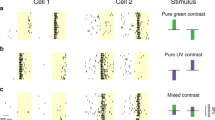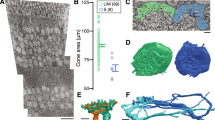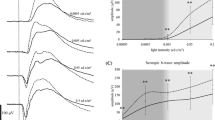Abstract
Fourier analysis is used to study resolution of images processed by the matrix of simulated red-center (BCR) and green-center (BCG) bipolar cells (BC) of the human central fovea. Simulated achromatic and chromatic sine and square waves, and a two-bar stimulus are used to activate the BCs. Due to the “honeycomb” packing of the cones and BC matrices Fourier transforms are computed row by row using a one-dimensional FFT. Resolution computed by the Fourier transform is compared with the resolution index (RI), which is a method for determining resolution based on two-point discrimination in the space domain. In general the harmonic with the maximum amplitude gives the best correlation with RI for the three stimuli. Amplitudes at all spatial frequencies are enhanced by increasing the number of cycles in the sine and square wave gratings. Results with simulated BCs compare favorably with human and macaque psychophysics measuring contrast sensitivity. Square wave gratings are better than sine wave greetings for studying resolution.
Similar content being viewed by others
References
Campbell FW, Carpenter RHS, Levinson JZ (1969) Visibility of aperiodic patterns compared with that of sinusoidal gratings. J Physiol (Lond) 204:283–298
Campbell FW, Robson JG (1968) Application of Fourier analysis to the visibility of gratings. J Physiol (Lond) 197:551–566
Valois RL de, Morgan H (1974) Psychophysical studies on monkey vision — III. Spatial luminance contrast sensitivity tests of macaque and human observers. Vision Res 14:75–81
Greenlee MW, Magnussen S (1987) Higher-harmonic adaptation and the detection of square wave gratings. Vision Res 27:249–255
Findlay JM (1969) A spatial integration effect in visual acuity. Vision Res 9:157–166
Hoekstra J, Goot DPA van der, Brink G van den, Bilsen FA (1974) The influence of the number of cycles upon the visual contrast threshold for spatial sine wave patterns. Vision Res 14:365–368
Mullen KT (1985) The contrast sensitivity of human colour vision to red-green and blue-yellow chromatic gratings. J Physiol (Lond) 359:381–400
Olzak LA, Thomas JP (1986) Seeing spatial patterns, In: Boff KR, Kaufman L, Thomas JP (eds) Handbook of perception and human performance, vol I, chap 7. Wiley, New York
Patel AS (1966) Spatial resolution by the human visual system. The effect of mean retinal illuminance. J Opt Soc Am 56:689–694
Savoy RL, McCann JJ (1975) Visibility of low spatial frequency sine-wave targets. J Opt Soc Am 65:343–350
Siminoff R (1991) Simulated bipolar cells in the fovea of human retina. Part I. Computer simulation. Biol Cybern 64:497–504
Siminoff R (1991) Simulated bipolar cells in the fovea of human retina. Part II. Spectral responses of bipolar cells. Biol Cybern 64:505–510
Siminoff R (1991) Simulated bipolar cells in the fovea of human retina. Part III. Effect of chromatic adaption on spectral responses of bipolar cells. Biol Cybern 66:357–364
Siminoff R (1991) Simulated bipolar cells in the central fovea of human retina. Part IV. Resolution. Biol Cybern (this issue)
Meeteren A van, Vos JJ (1972) Resolution and contrast sensitivity at low luminances. Vision Res 12:825–833
Author information
Authors and Affiliations
Additional information
The major portion of this work was done while the author was a Senior Research Associate of the National Research Council, USA
Rights and permissions
About this article
Cite this article
Siminoff, R. Simulated bipolar cells in fovea of human retina. Biol. Cybern. 66, 137–150 (1991). https://doi.org/10.1007/BF00243289
Received:
Accepted:
Issue Date:
DOI: https://doi.org/10.1007/BF00243289




